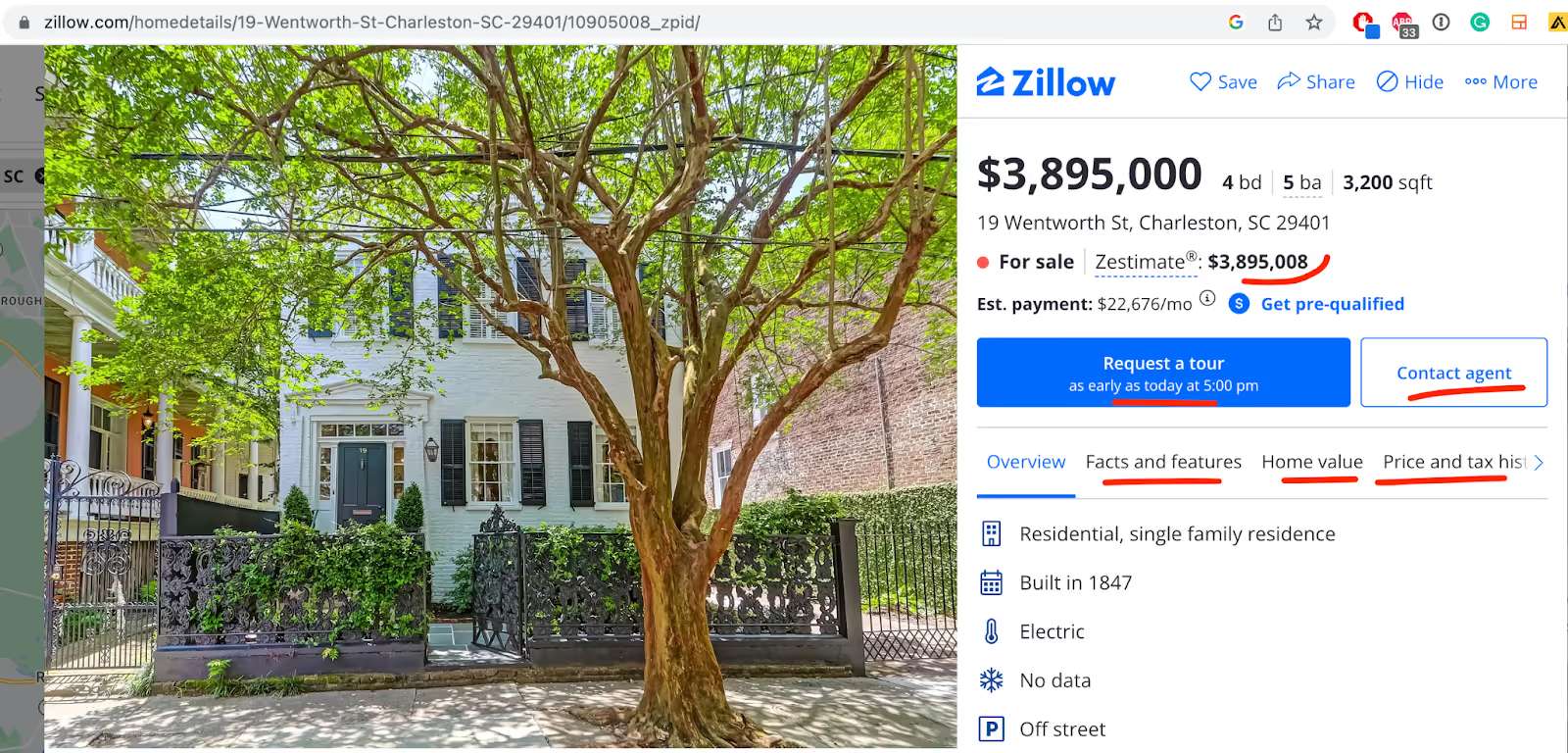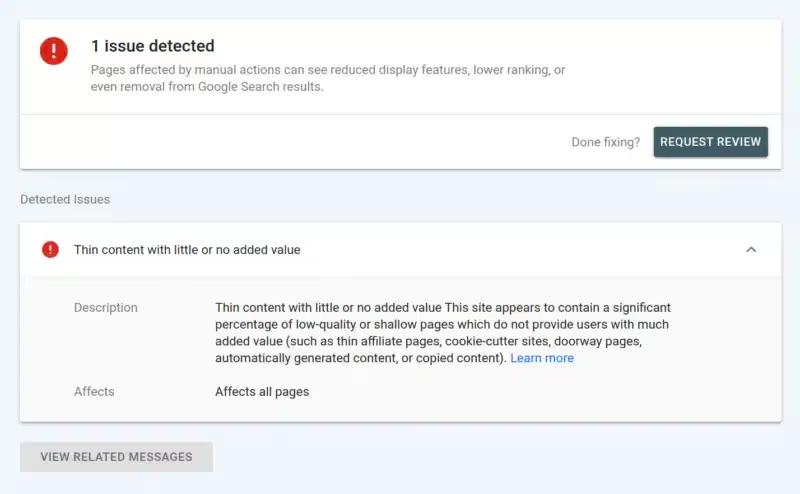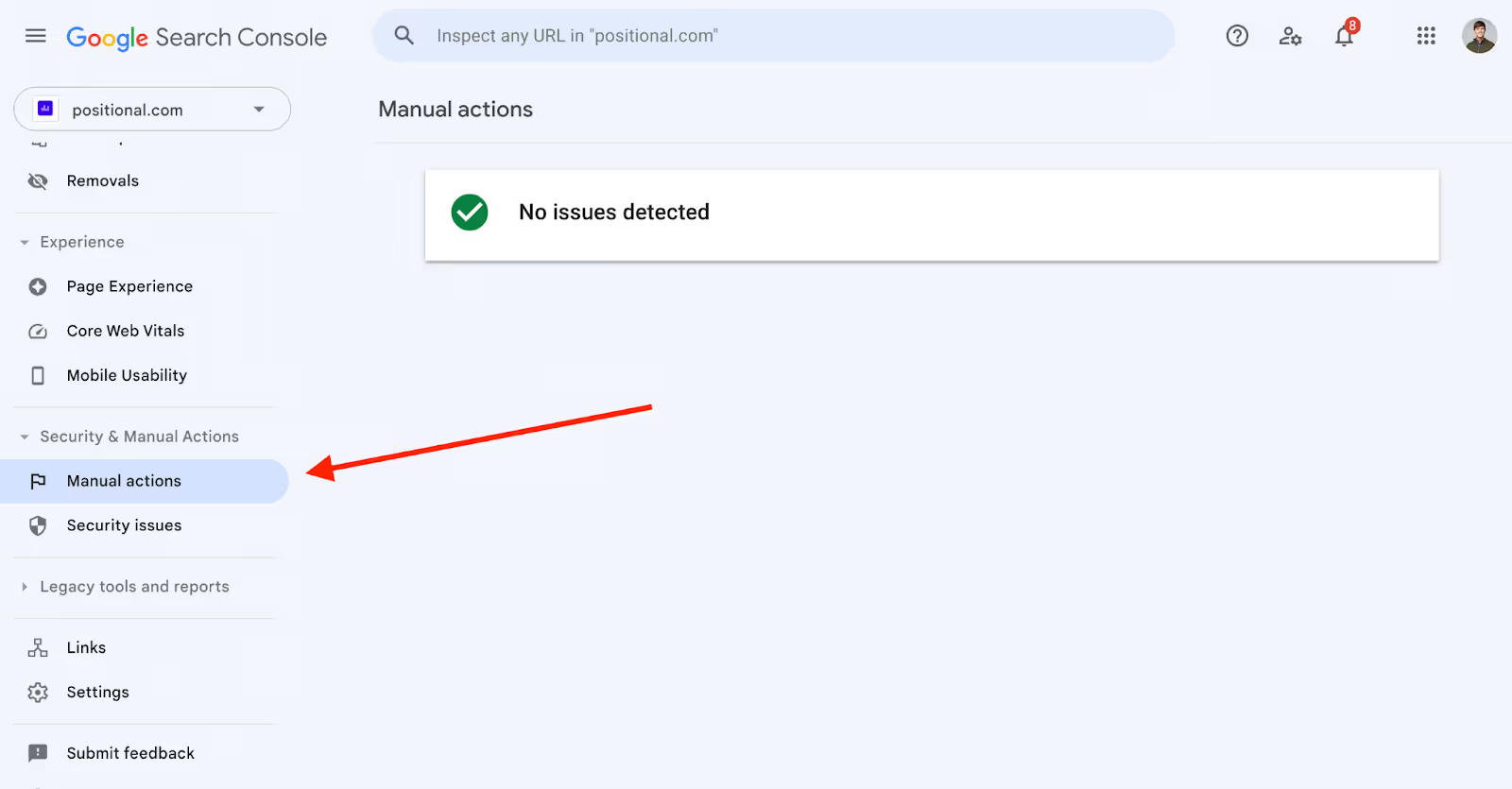The quality of the content you publish is more important than ever. And over the past decade, Google has become very good at judging the quality and depth of the content you create.
In brief, thin content is low-quality content that provides little or no value for searchers. From Google’s perspective, showing thin content in search results would reduce the quality of its experience for its customers (the searchers). Over the years, Google has introduced a number of algorithmic penalties targeted at thin content, and they’ll also take manual action if necessary.
There are many different types of thin content. Google has provided a number of examples of thin content, including pages with little substance (for example, 200-word articles), doorway pages, pages created automatically or programmatically, and low-value but heavily promotional content (for example, low-quality affiliate content).
In this article, we’ll explain what thin content is, highlight six different types of thin content, summarize Google’s penalties for thin content, and show you how to fix thin content issues.
What Is Thin Content?
Google is in the business of providing high-quality content to its searchers. For each search query or question asked by searchers, Google’s goal is to provide a comprehensive result that aligns with search intent. “Search intent” is a popular term used to describe the purpose of a Google search and the reason why someone is performing a specific search.
In a broader sense, thin content is a webpage that doesn’t sufficiently address the search intent (or searcher question) it promises to.
It’s not necessarily how many words are on the page, although too few words may be an issue. When you’re creating content on your website, Google wants you to go into enough depth that your webpage sufficiently answers a user's question or query. That being said, Google realizes that not every search question needs to be answered with a 1,500-word blog post. Depending on the intent of the search and the topic, the word count needed and the depth required will vary.
And for transaction pages — for example, an e-commerce website selling surfboards — you may not need substantial content at all. In cases like this, you should think about what content a page needs in order to be uniquely valuable for a searcher with buying intent, for example, a category product page.
If Google detects thin content, algorithmically or through a manual review, your website may suffer in rankings. Regardless, thin content will lead to a host of other problems, including unhappy visitors, higher bounce rates, lower scroll depth, keyword cannibalization, and, likely, fewer organic backlinks to your website.
6 Types of Thin Content
Not all thin content is the same. In fact, there are many different types of thin content, and Google has defined specific examples. Here are six different types of thin content.
1. Content Lacking Depth
Simply put, if you’re generating a large number of pages with very little or insufficient content on them (for example, 200 words on the page), you’re at risk of creating thin content.
If I were building blog posts on financial topics like “How to File Your Taxes in South Carolina” or “How LIBOR Interest Rates Are Determined,” it would be hard for me to cover these topics in, let’s say, 250 words. For either of these posts, I’d expect that I’d need 1,000-plus words to write an in-depth guide.
If your articles are too short, you likely aren’t giving the searcher a high-quality answer to their question or query. And as a result, the searcher will likely need to go to another website for a more complete answer. Google uses return to search rate as a way to judge the quality of the content on your website. In addition, if you’re creating very short posts or pages, you’re likely missing out on a large number of long-tail keywords that your posts could also rank for.
For each piece of content you create, you’ll first want to get a sense of what’s already ranking in search for a given keyword. If, for example, the top five posts for a given keyword use 2,000 words to explain a topic, you’ll have a very difficult time ranking a 400-word blog post on the first page of search results.
With Positional, our Optimize toolset helps prevent thin content by telling you how many words to use to create great content. For the financial topics I mentioned above, it estimates that you’d need 1,042 words and 10,561 words, respectively. This calculation takes into account the word count and depth of the current top ranking pages for each keyword.
2. Programmatically Created Content
There’s certainly a place and a purpose for programmatically created content. For example, Zillow programmatically creates a large number of pages for properties on its website, and they rank very well in Google search results.
Programmatically created content is not necessarily thin content. However, if you’re creating large amounts of content programmatically and you aren’t adding any new or additional value to those pages, this content could be considered thin. Moreover, if the pages do not align with the search intent related to a given keyword, they could also be considered thin.
For example, if you’re scraping other websites and then using that data to generate a large number of programmatically created pages without actually adding anything new to that content, that content would be considered thin.
When you’re creating pages programmatically, you should think critically about what unique value your pages provide for searchers.

Zillow offers unique value by providing its own estimates, relevant data like tax expenses, and the history of property values over time. They also allow you to request a tour automatically. Zillow is using its own unique and valuable data to enrich its programmatically created pages.
3. AI-Generated Content
In 2023, AI-generated content started becoming very popular. If you’ve used AI to create substantial amounts of content on your website — and this content is generally unhelpful, vague, or inaccurate, as AI-generated content often is — then this content may be considered thin.
Google’s stance on AI-generated content has shifted dramatically over the past year. In April 2022, John Mueller clearly stated that AI-generated content would be considered spam. However, in early 2023, Google clarified its position by saying that AI can be used in the content creation process but that AI should be a helpful supplement and not used for the purpose of manufacturing or manipulating search engine rankings.

When creating content with AI, you should work to add your own expertise and experience to the content you create, in line with Google’s E-E-A-T guidelines. Websites that have simply copied and pasted AI-generated content at scale are likely to experience indexing issues and are at a higher risk of experiencing thin content, or spam, penalties.
At Positional, our AutoDetect toolset can be used to detect AI-generated content and flag portions of text within an article that are heavily AI written.
4. Duplicate Content
While not all duplicate content is thin content, sites with large amounts of thin content will likely have issues with duplicate content as well. Duplicate content is simply content that is identical or very similar to content on other pages of your website or on third-party websites. For example, if you have a webpage about the best car insurance in Florida, and you also have a page on the best car insurance in South Carolina, but these pages are virtually identical, they would be considered duplicate content. They may also be considered thin, given that the search intent for these queries is likely quite different.
Duplicate content confuses Google — it doesn’t know which article on your website should rank in organic search. And if you’ve reused substantial portions of content across multiple articles, it’s highly likely that each of those articles would be considered thin content, given that the search intent is probably different for each, and your pages don’t sufficiently address the unique search they’re designed to rank for.
Each page or post on your website should be created with a specific primary keyword in mind. And each post on your website should have unique and valuable content to serve that keyword or query. Positional’s AutoDetect toolset can flag duplicate or plagiarized content on your website and on third-party websites.
5. Doorway Pages
Doorway pages, often referred to as gateway or bridge pages, are low-quality and low-value pages that are designed to rank for a specific search query but that offers little value to the searcher. Doorway pages are typically considered to be thin content.
They’re called doorway pages because they themselves are not designed to be that valuable; instead, they’re meant to redirect visitors to another page on your website.
For example, a company in the car insurance niche might have a large number of doorway pages created for specific cities in South Carolina:
- Best Car Insurance in Charleston, South Carolina
- Best Car Insurance in Mount Pleasant, South Carolina
- Best Car Insurance in Kiawah, South Carolina
It’s unlikely that these pages are substantially different or uniquely valuable. Instead, these pages may be designed to rank well in search for a specific keyword, only to then redirect a reader to another page on the website or to another third-party website.
However, if each of these pages had truly helpful information for a searcher in that specific city — for example, average car insurance rates or specific companies that offer coverage only in that city — they actually might be quite helpful.
6. Overly Promotional Content and Affiliate Content
Google has made it clear that overly promotional or low-quality affiliate content is thin content. However, having spent quite a few years in the affiliate marketing space myself, I know that not all affiliate content is thin content.
From my perspective, what Google is getting at here is that if you have a large number of affiliate-focused articles that have little or no value, then those pages would be considered thin. For example, if you were writing blog post reviews about a certain type of product when in fact, you had no actual experience with that product, it would be much more difficult for you to write a uniquely helpful article. Instead, what you’d likely do is regurgitate general information that doesn’t actually add anything new for the searcher.
Also, having too many ads, or calls to action (CTAs), on a page itself might overpower the page and disrupt the user experience. This disruption could mean that the page is deemed thin content, even if the information on it is quite comprehensive. Your pages might also have very poor user metrics like bounce rate and scroll depth, which would signal to Google that your page is a low-quality one.
Google’s Thin Content Penalties
Google imposes penalties on pages that contain thin content, and there are a couple of ways it arrives at this determination.
Google Panda
In 2011, Google released an algorithm update called Google Panda, which was created to remove webspam from search engine results. Prior to the release of Panda, many search engine result pages (SERPs)were overwhelmed by low-quality and thin content.
Panda had a massive impact on search when it was released, with nearly 12% of all search queries impacted. If you’re creating large amounts of thin content, your website may be caught in one of the Panda filters, and as a result, it won’t rank as well (or at all) in Google search. On the flip side, if you’re creating fantastic content, Panda is designed to reward and promote that content in search listings.
Manual Actions
While Google’s algorithm is constantly looking for thin content, the Google Search Team may also manually apply penalties to your website. In 2013, Google announced that it would be issuing manual penalties for thin content (for example, spun content) or webpages that deliver very little value. Google is likely algorithmically flagging websites for manual review and then, after the manual review, applying a thin content penalty if it thinks one is warranted.

Source: Search Engine Land
Google has stated that the manual penalties may apply to your website as a whole if there are “sitewide” issues. And Google has gone on to say that it also applies “partial match” penalties to websites where a portion of the website is violating its guidelines.
Check for Manual Actions in Google Search Console

If you’re subject to manual action, Google will communicate this to you in the Search Console Message Center. You can also go to Security & Manual Actions: Manual Actions in Search Console to see these actions directly.
How to Fix Thin Content | 4 Steps
Whether you’ve recently been impacted by a Google penalty or you’d just like to improve your website’s rankings, you should take action to fix thin content issues on your website.
Step 1: Delete It
If you have a large number of thin pages and you don’t think they’re worth improving, then you should delete them.
However, before deleting them, you should check to see whether they’re currently ranking and driving traffic to your website. If they are, in fact, ranking and driving traffic, you might consider reworking and improving the content before deleting them.
After deleting the posts, you should make sure that you 301 redirect the previous URLs to other helpful or related posts on your website to avoid a large number of new 404-ing pages.
Step 2: Add More Value by Rewriting
If you have a large number of thin pages that are currently ranking somewhat well, you should consider these pages as candidates for an overhaul. If you add additional content and helpful information to these pages, they will no longer be considered thin content and will likely improve in search rankings. Before making your edits, you should analyze competitor content that is currently ranking well for the target keyword.
If word count and depth of content are the issues, you should consider using a content optimization toolset. At Positional, our Optimize toolset can be used to optimize content, improve existing pages, and create great new content. For example, our toolset will provide recommended word counts based on what’s already ranking well and provide suggestions for keyword density and related keywords that you’re currently missing.
Step 3: Consolidate Content
If you have a large number of very similar posts, you may be running into keyword cannibalization issues in addition to thin content issues.
If you’re able to identify a number of very similar pages, all designed to rank for the same primary keyword, you should consolidate these pages into a single helpful page. You’ll be much better off attempting to rank a single, fantastic, 1,500-word blog post than five very similar 300-word articles.
In situations where the primary keywords are very similar, if you’re confused about which posts should be combined and which should be split, it’s best to look at what’s currently ranking for the different variations of the primary keyword. For example, if the top five search results for each keyword are nearly identical, that is a signal that you should combine these keywords into a single article. However, if the top five search results for each keyword are very different, that is a signal that you should leave them as separate standalone posts. From there, I would work to improve the quality and depth of each piece.
Step 4: Request Reconsideration in Google Search Console
If you’re subject to a manual penalty as a result of thin content, and you’ve made improvements to your website, you should submit a reconsideration request in Google Search Console.

Source: Advanced Web Rankings
By doing so, you’re requesting that Google re-evaluate your website manually. If your improvements are deemed acceptable, the Google team will remove the penalty. Be sure to provide specific details on the steps you’ve taken to fix the problems with your website.
Google does not provide specific timelines on how long it will take them to review your request, although it typically takes weeks to months for the request to be processed and your website to be re-evaluated. So submit this request only when you’re very confident that the steps you’ve taken solve the issues Google has identified.
After the penalty is removed, it may take some time for your pages to re-rank and perform in search results — but going forward, your website should be positioned to succeed.
Final Thoughts
Thin content is problematic for searchers, Google, and your website. In many cases, thin content may mean that a site’s content lacks sufficient depth and information. In others, thin content may mean that a site’s content doesn’t sufficiently address the search intent for the targeted keyword.
To recap, you should know that there are many different types of thin content, including content that is too short and unhelpful, programmatically generated content, AI-generated content, duplicate content, doorway pages, and overly promotional pages.
If you’ve been impacted by an algorithmic penalty or a manual action, there are steps you can take to improve your website. Start by taking inventory of all of the pages on your website. From there, you should work to delete, rewrite, improve, and consolidate your site’s problematic content. And if you’ve been impacted by a manual action, you should submit a reconsideration request after you’ve made improvements.
If you have any questions about thin content or creating better content, feel free to contact me directly at nate@positional.com. And if you’re interested in learning more about Positional, we’d love to speak with you. At Positional, we offer a number of tools for improving the quality of the content on your website, including Optimize for content optimization and AutoDetect for detecting AI-generated content. You can sign up for our private beta on the homepage of our website.





